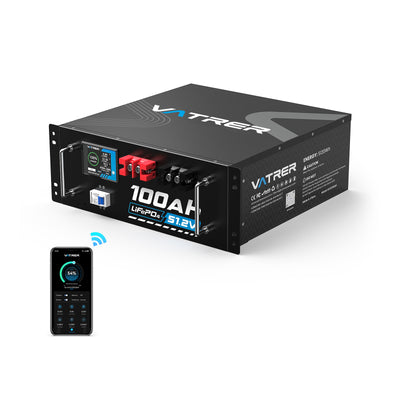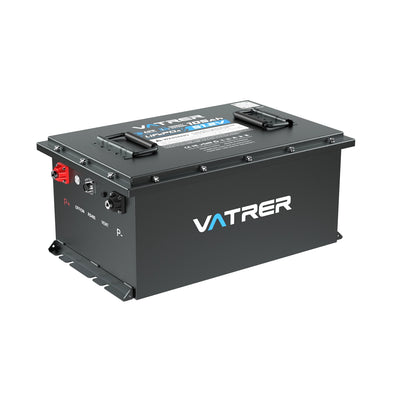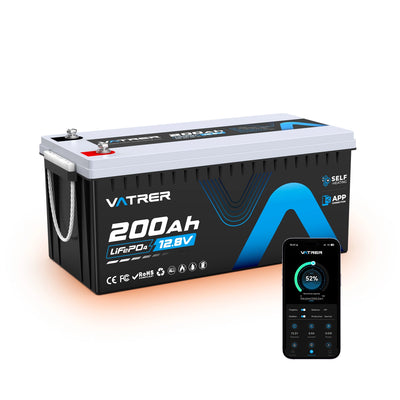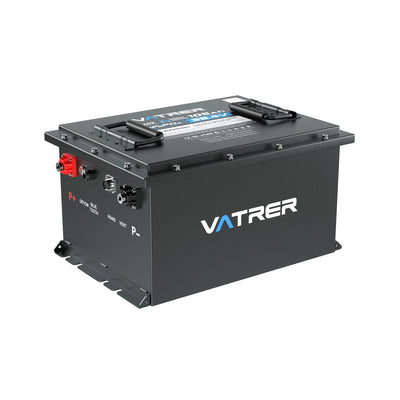
How Many Hours Will a 100Ah Battery Last?
Over the last few years, I’ve come to depend on lithium batteries for almost everything, from short weekend breaks in the motorhome to supporting my small home solar system. One trip in particular stands out: I set off for a remote camping spot in the Rockies, only to discover that my ageing lead-acid battery gave up after just a few hours of running a few lights and a fan.
That rather disappointing episode finally convinced me to upgrade to a 100Ah lithium battery, and since then I’ve been keen to understand how to get the most out of it. If you are asking yourself the same question—“How long will a 100Ah battery actually last?”—you are in the right place. Below I’ll share what I have learned in practice, so you can plan your power system with more confidence and less guesswork.

What Are Ampere-Hours? Making Sense of 100Ah Battery Capacity
It helps to begin with the fundamentals, because when I first looked into batteries, the specification labels might as well have been written in code. Battery capacity describes how much electrical charge a battery can store and is expressed in ampere-hours (Ah)—you can think of it as the size of the tank. A 100Ah battery can, in theory, supply 100 amps for one hour or, for example, 5 amps for 20 hours before it is fully discharged.
In everyday use, though, most of us are not running a steady 100-amp load. In my home solar setup, I rely on a 100Ah deep cycle battery simply to keep a fridge running quietly through the night.
Converting ampere-hours into watt-hours (Wh) gives a clearer idea of the energy available. You multiply the Ah value by the battery voltage (12V in most small systems), so 100Ah × 12V = 1,200Wh. In other words, the battery can theoretically supply 1,200 watts for one hour, or 100 watts for around 12 hours, assuming no efficiency losses.
The crucial point is matching this stored energy to what your equipment actually consumes. Once I started paying attention to Ah and Wh instead of guessing, I stopped over-sizing systems or running short unexpectedly. Understanding ampere-hours is really the first step towards predicting how long your battery will run.
Which 100Ah Battery Type Fits Your Needs? A Practical Comparison
Selecting the right battery technology makes a noticeable difference. My previous 100Ah AGM battery was reasonably priced, but it was heavy and limited in usable capacity, and it let me down on a wet weekend trip in the RV. Here is how the main 100Ah options compare in practice:
- Lead-Acid: The most economical option, typically weighing 55–65 lbs, with a recommended 50% depth of discharge (DoD), which means only half of the rated capacity should be used regularly. Expect around 300–500 cycles. This type is suitable for backup roles such as automotive support or uninterruptible power supplies (UPS).
- Lithium-Ion: Very light (around 20–25 lbs), with roughly 80% usable DoD and around 3,000–5,000 cycles in traction-style packs. Many designs use nickel-manganese-cobalt (NMC) cathodes for high energy density, which works well for compact products such as e-bikes or portable devices.
- LiFePO4: Usually weighs 25–30 lbs, allows up to 100% DoD in normal operation, and typically delivers 2,000–5,000 cycles. The iron phosphate cathode offers excellent thermal stability, making this chemistry safer and well suited to daily use in solar systems, motorhomes, or boats.
LiFePO4’s tolerance for deep discharges and low temperatures (around -4°F to 140°F) kept my equipment running reliably during a winter trip in a camper van. The underlying chemistry is important: lithium-based batteries use a carbon anode and a lithium salt electrolyte, while the choice of cathode—NMC or LiFePO4—determines much of the performance. NMC prioritises energy density for electric vehicles, whereas LiFePO4 focuses on safety and long service life. The table below gives a side-by-side overview:
| Battery Type | Weight (lbs) | Usable Capacity (% DoD) | Cycle Life | Safety Features | Best For |
|---|---|---|---|---|---|
| 100Ah AGM (Lead-Acid) | 55-65 | 50% | 300-500 | Requires ventilation (hydrogen gas risk) | Automotive, UPS |
| 100Ah Lithium-Ion | 20-25 | 80% | 500-1,000 | Potential thermal runaway if damaged | E-bikes, electronics |
| 100Ah LiFePO4 | 25-30 | 100% | 2,000-5,000 | High thermal stability, very low fire risk | Solar, RVs, marine |
After comparing real-world performance, I chose a 100Ah LiFePO4 battery because it combines durability with a strong safety profile.
Step-by-Step: Calculating How Long a 100Ah Battery Will Run in Your System
Now for the practical part: working out actual runtimes. I first did this during a power cut, scribbling figures on a piece of paper, and it turned a stressful situation into something manageable. To estimate how long a 100Ah battery will last, start by converting to watt-hours: 100Ah × 12V = 1,200Wh.
Then consider depth of discharge (DoD)—a lead-acid battery at 50% DoD provides about 600Wh of usable energy, whereas a 100Ah LiFePO4 battery can typically make use of the full 1,200Wh. Next, account for inverter efficiency (often around 90–95% when converting to AC) plus small losses in cables and the battery management system (BMS, roughly 2–5%). For a LiFePO4 pack, this might give a realistic net of about 1,080Wh (1,200Wh × 0.90).
The final step is to divide by your total load: Runtime (hours) = Net Wh ÷ Watts. For a 100W fan, the calculation is 1,080Wh ÷ 100W ≈ 10.8 hours. I often use free online amp-hour calculators to confirm my rough estimates, which saves me from doing mental arithmetic when travelling.
One practical tip from experience: add roughly 10% to your expected consumption for “hidden” loads such as chargers or standby devices. This simple method has kept my lights and essential kit running through several storms and grid failures.
Key Factors That Affect 100Ah Battery Runtime in Real Conditions
Even with sound calculations, real-world runtime is never completely fixed. On a long motorhome journey across several climate zones, I watched my 100Ah lithium battery drain faster than expected in very high temperatures, which reminded me how important these influencing factors are.
The connected load is the main driver—larger appliances (such as a 500W microwave) significantly reduce runtime, while efficient LED lighting or small electronics use relatively little power. The discharge rate, often described as C-rate, is important as well: a 1C load would empty a full battery in one hour; at 2C, that time halves. LiFePO4 batteries can usually handle 3C–5C without complaint, whereas lead-acid batteries are happier at around 0.2C.
Age and usage history gradually reduce capacity—after about 500 cycles, you might see a 10–20% drop if the battery has been pushed hard. Self-discharge is another factor: traditional lead-acid batteries can lose around 4% of their charge per week in storage, while LiFePO4 typically loses only 2–3% per month. Temperature has a strong effect too—at temperatures below about 14°F, available capacity may fall by half, although my Vatrer low-temperature cut-off batteries protect themselves in such conditions.
Vibration and humidity, for example on rough tracks or in damp storage spaces, also contribute to wear. I now monitor my batteries via a BMS app, which makes it easier to see how these variables affect performance and to adjust my expectations accordingly.
How Long a 100Ah Battery Can Run Typical Everyday Loads
This is where real use meets the theory from the calculator. For small loads, such as a 20W internet router during a power cut, my 100Ah LiFePO4 battery can keep things connected for more than 50 hours—more than enough for a long weekend of streaming and work.
For medium-sized loads, such as a 500W fridge in a small off-grid cabin, I see around 2 hours of runtime from a fully charged 100Ah battery. High-power equipment is different: a 2,000W power tool may only run for about half an hour, which is why I use larger banks for workshop use.
In the motorhome, a combination of a 10W light, a 50W television and a 30W fan (90W in total) gives me roughly 12 hours of runtime—more than enough for a relaxed evening.
For golf carts, the outcome depends heavily on terrain. On level ground, a 10A draw can last about 8 hours, while hilly routes may reduce that to 4 hours. On boats, I often connect several batteries in parallel—four 12V 100Ah batteries can support a 100W load for around 48 hours.
These examples are taken from my own trips rather than from theory. To summarise, here is an approximate runtime chart for a 100Ah LiFePO4 battery (around 1,080Wh usable):
| Load Example | Total Watts | Estimated Hours |
|---|---|---|
| Router + LED Lights | 30 | 36 |
| Fridge | 500 | 2.2 |
| TV + Fan | 100 | 10.8 |
| Power Tool Burst | 2,000 | 0.5 |
Figures like these are very helpful when planning your next journey or off-grid stay.
Maximising Both Lifetime and Runtime of Your 100Ah Battery
Knowing how long a battery can last is useful, but extending that runtime and overall lifespan is where you really gain value. After damaging a battery through over-discharge on a solo trip, I completely changed my approach—and it has paid off.
Use a charger that is correctly matched to your battery and BMS to prevent overcharging; LiFePO4 batteries perform best with a charging voltage around 14.6V. Try to limit regular discharges according to your battery type—around 50% for lead-acid and up to 80–100% for LiFePO4—and store batteries in moderate temperatures (roughly 50–77°F) to reduce self-discharge and stress on the cells. Clean terminals every few months, particularly in dusty or coastal locations, and if you still use lead-acid, top up with distilled water as required.
For lithium batteries, Bluetooth monitoring (as with my Vatrer Battery) makes it easy to spot issues early and correct them. When packs eventually reach the end of their life, take them to a suitable recycling point so materials are handled safely. Following these simple routines has effectively doubled the service life I can expect from my batteries.
Plan Effectively for Reliable Power from a 100Ah Battery
In summary, working out how many hours a 100Ah battery will last comes down to understanding its capacity, the loads you connect, and the way you operate and maintain the system—whether that system is installed in an RV, a small boat, or a home solar installation. From my early mistakes to more recent, smooth-running trips, LiFePO4 has consistently offered the best balance of depth of discharge and cycle life compared with traditional lead-acid batteries.
If you are preparing your own setup, it is worth looking at the Vatrer 100Ah battery. Its integrated low-temperature cut-off, self-heating function, IP65 water resistance and Bluetooth monitoring make it a strong choice for cold mornings, damp conditions, and everyday use. On top of that, you still get more than 5,000 cycles and a 100A BMS for protection—features that kept my most recent trip fully powered right through the night.
FAQs
How Long Does It Take to Charge a 100Ah Battery with a 200W Solar Panel?
The charging time depends on the battery technology, the true output of the solar panel, and local conditions. For a 100Ah LiFePO4 battery (12V, around 1,200Wh capacity), a 200W solar panel will deliver less than its rated power due to losses (around 15–20% from panel efficiency, the charge controller, and cabling). If we assume about 160W of effective power (200W × 0.8) and roughly 6 hours of strong sunlight per day:
- Calculation: Charging time = Battery Capacity (Wh) ÷ Effective Solar Power (W) = 1,200Wh ÷ 160W ≈ 7.5 hours under ideal conditions (clear sky, good panel angle).
- Real-World Adjustment: Cloud cover, shading, or poor orientation can extend this to 10–12 hours and may spread the recharge over 2 days in changeable weather.
Using a high-quality MPPT charge controller helps you capture more of the panel’s output. If you need faster charging, consider upgrading to a 300W array or combining solar with a 10A mains charger (which will typically charge in around 10 hours). Keep panels clean and angled towards the sun to maintain efficiency. In my off-grid cabin, a 200W panel with an MPPT controller usually restores my Vatrer 100Ah battery in about 8 hours on clear days.
How Long Will a 100Ah Battery Run a Trolling Motor?
The runtime of a trolling motor on a 100Ah battery depends mainly on the motor’s power draw, which is often in the range of 300–600W for small to medium motors (roughly 30–55 lbs of thrust). For a 100Ah LiFePO4 battery (about 1,200Wh, with approximately 1,080Wh usable after typical system losses):
- 300W Motor: 1,080Wh ÷ 300W ≈ 3.6 hours at full power.
- 600W Motor: 1,080Wh ÷ 600W ≈ 1.8 hours at full power.
- Real-World Use: Most people rarely run at full throttle. At around 50% output, a 300W motor effectively drawing about 150W could run for around 7.2 hours.
A LiFePO4 battery is advantageous here because its 100% DoD allows you to use the full 1,200Wh, compared with about 600Wh from a similarly rated lead-acid battery at 50% DoD. Monitor usage with a BMS app so you do not discharge too deeply. For longer days on the water, I either carry a second Vatrer 100Ah battery or connect two in parallel (2,400Wh) to get roughly 7–14 hours at 300W. Keeping the propeller clear of weeds and debris also helps reduce unnecessary power draw.
How Many Watts Is a 100Ah Battery?
Strictly speaking, a 100Ah battery is rated in watt-hours (Wh) rather than watts. Watts measure the rate at which energy is used, whereas watt-hours indicate the total amount of energy stored. For a 100Ah battery operating at 12V:
- Calculation: Wh = Ah × Voltage = 100Ah × 12V = 1,200Wh
- Usable Capacity: For LiFePO4 (100% DoD) you can use close to the full 1,200Wh; for lead-acid (around 50% DoD) you should plan on about 600Wh. After allowing for inverter efficiency (about 85–95%), a 100Ah LiFePO4 battery effectively provides roughly 1,020–1,140Wh.
This means that, in practice, it could run a 100W appliance for about 10–11 hours, or a 1,000W appliance for close to 1 hour. Always check the power rating (watts) on the equipment label and compare this with the battery’s available Wh. For several devices running together, a plug-in watt meter is a useful tool to measure overall consumption. I use this approach in my RV to ensure that a 100Ah battery can support my typical loads without pushing the system too hard.
How Do I Size a 100Ah Battery System for My Solar Setup?
Sizing a 100Ah battery for a solar installation starts with estimating your daily energy demand and then comparing it to the battery storage and solar input. A 100Ah LiFePO4 battery stores roughly 1,200Wh (about 1,080Wh after typical conversion losses). Work out your daily usage; for example, a 500W fridge running for 4 hours consumes around 2,000Wh per day:
- One 100Ah Battery: Provides about 1,080Wh of usable energy, which is not enough to cover a 2,000Wh daily load on its own.
In this example, two 100Ah batteries in parallel (around 2,400Wh) are more appropriate. Combine them with a 400W solar array, which can typically produce 2,400Wh over 6–8 hours of strong sunshine, and an MPPT controller for higher efficiency. In my own cabin system, I use a pair of Vatrer 100Ah batteries and a 400W panel to power lighting, a fridge, and a fan each day. Always total up the wattages of your appliances and then add a buffer of about 20% for inefficiencies and unexpected usage.
What Should I Do If My 100Ah Battery Isn’t Lasting as Long as Expected?
If your 100Ah battery seems to be providing less runtime than your calculations suggest, it is worth checking a few common causes:
- Higher Than Expected Load: Confirm the true power draw of your appliances with a watt meter; starting surges or standby loads can increase consumption without you realising.
- Battery Condition: Check voltage readings or BMS data. After 500 or more cycles, especially with frequent deep discharges, the effective capacity may have reduced.
- Charging Problems: Make sure your charger uses the correct profile (around 14.6V for LiFePO4). Very slow or incomplete charging can point to a failing charger or insufficient solar input.
- Environmental Effects: Very low temperatures (below about 14°F) and high heat (above around 104°F) both reduce performance. Insulated boxes or low-temperature-rated batteries can help.
To test the system, connect a known load (for example a 100W lamp) and time how long it runs from full to the recommended cut-off. If the result is far below expectations, the battery or charger may need attention. Upgrading to a battery with integrated BMS monitoring, such as Vatrer’s 100Ah LiFePO4, allows you to diagnose issues via Bluetooth. In my solar system, an unexpectedly short runtime was eventually traced to a failing charger; once replaced, the battery returned to its original performance.
Share
2 comments
This guide is super helpful for figuring out how long my 100Ah battery might last! It breaks down the math in a way that’s easy to understand, even for someone like me who isn’t a battery expert. I like how it mentions that the actual time can change depending on what I’m powering and other things. Thanks for the clear explanations! https://inverterreview.com/tag/500w-inverters/
How does lithium battery differ from other batteries i.e lead acid, gel or agm. 1280wh/100ah lithium battery is equivalent to how many lead acid battery of 200ah? Thanks



















































